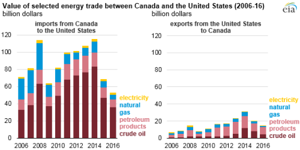EIA: Canada is the largest US partner for energy trade
Canada is the largest energy trading partner of the United States. Based on the latest annual data from the US Census Bureau, energy accounted for about 5% of the value of all US exports to Canada and more than 19% of the value of all US imports from Canada in 2016.
While the value of bilateral energy trade with Canada has varied over past decade, driven primarily by changes in prices of oil and natural gas, the overall structure of bilateral energy trade flows has changed relatively little, and US energy imports from Canada has exceeded US energy exports to Canada by a large margin. In 2015 and 2016, the value of US energy imports from Canada and the value of US energy exports to Canada both fell, reflecting declining prices of key commodities such as crude oil, petroleum products, and natural gas. For 2016, the value of US energy imports from Canada was $53 billion, while the value of US energy exports to Canada was $14 billion.
Crude Oil
Crude oil makes up most US energy imports from Canada, averaging 3.3 MMbpd in 2016. Canada is by far the largest source of US crude oil imports, providing 41% of total US crude oil imports in 2016. Sales of Canadian crude oil to the United States reached more than $83 billion in 2014. As oil prices fell in 2015 and 2016, the value of US crude oil imports from Canada fell from $47 billion in 2015 to $36 billion in 2016, despite increasing in volume. Canada’s crude oil exports to the United States, which are produced in Alberta and are shipped primarily to the Midwest and Gulf Coast regions of the United States, consist mainly of heavy grades.
Until 2013, virtually all US crude oil exports went to Canada. However, as the United States has exported more crude oil to other countries, Canada has made up a smaller share of US crude oil exports. In 2016, an average of 301,000 bpd of US crude oil was exported to Canada and 219,000 bpd to all other countries. US crude oil exports to Canada are typically light, sweet grades that are shipped to the eastern part of the country.
Petroleum Products
Bilateral petroleum products trade with Canada is relatively balanced in both volumetric and value terms. Canada was the destination for 564,000 bpd of petroleum products in 2016, or 12% of all petroleum products exported from the United States. These exports were valued at more than $8.2 billion. However, the mix of petroleum product flows between the United States and Canada varies by product and region. For example, the United States is a net importer of gasoline from Canada, with significant volumes flowing from refineries in Eastern Canada to serve markets in the Northeast United States.
Conversely, very little of the petroleum products exported from the United States to Canada are finished transportation fuels. Pentanes plus, liquefied petroleum gases, and other oils make up the majority of US product exports to Canada. Some of these products are used as a diluent to enable pipeline movement of heavy crude oils produced in Canada. On balance, the United States is a net exporter in its bilateral petroleum product trade with Canada, and US petroleum product exports to Canada (and other destinations) have been gradually increasing over the past decade.
Natural Gas
Bilateral natural gas trade between Canada and the United States is dominated by pipeline shipments. Natural gas imports from Canada averaged 8.0 Bcfd in 2016, or 97% of all US natural gas imports. Total natural gas imports from Canada were valued at more than $5.9 billion in 2016. Most of Canada’s natural gas exports to the United States originate in Western Canada and are shipped to US markets in the West, Midwest, and Northeast. Increases in natural gas production in the Marcellus and Utica plays have made the United States less dependent on Western Canadian natural gas imports in northeastern markets.
US natural gas exports to Canada, which averaged 1.9 Bcfd in 2015 and 2.1 Bcfd in 2016, mainly go from Michigan and New York into eastern provinces. Increases in pipeline capacity to carry natural gas out of the Marcellus and Utica shale formations may enable increased flows of US gas into Canada over the next several years.







Comments